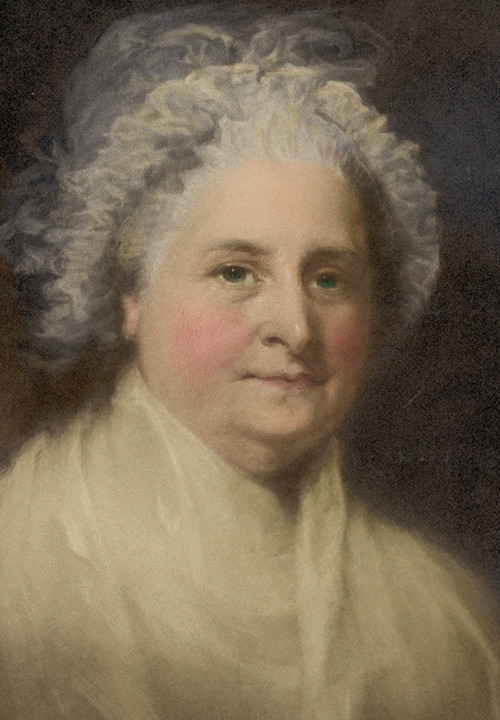
Martha Washington
Years of service: 1789-1797
Born: 1731

Martha was George Washington's secret asset against the British during the American Revolution. The war lasted for eight and a half years, and Martha spent over five years with the soldiers during the coldest and harshest months at the winter encampment. Made from the hands of the enslaved at Mount Vernon, she brought food, wool, and medicine. She stayed to knit socks and tend to the wounded at the campsite. She hoped to retire and lead a restful life with her husband when the war ended. When George became the first president to lead the new country, Martha accepted the sacrifice of his public demands over her private desires.
Born: June 2, 1731, Chestnut Grove Plantation, New Kent County, Virginia
Died: May 22, 1802, Mount Vernon, Virginia
Early Life and Family Background
Martha Dandridge was born on June 2, 1731, at Chestnut Grove Plantation in New Kent County, Virginia. She was the eldest child of John Dandridge and Frances Jones. Her father, John Dandridge, emigrated from England to Virginia in 1715 and served as a planter and clerk of New Kent County. Her mother, Frances Jones, came from a prominent Virginia family. Martha’s ancestry was a mix of English, Welsh, and French heritage.
Education and Upbringing
Martha received an informal education typical of girls of her social class. She was trained at home in music, sewing, household management, and other domestic skills necessary for managing a plantation. Additionally, she likely received wider education in plantation management, crop sales, homeopathic medicine, and animal husbandry.
First Marriage and Widowhood
At 19, Martha married Daniel Parke Custis, a wealthy plantation owner and enslaver, on May 15, 1750. They lived at a mansion called "White House" on the Pamunkey River and together, they had four children: Daniel Parke Custis Jr., Frances Parke Custis, John Parke Custis, and Martha Parke Custis. Tragically, two of their children died young, and in 1757, Daniel Custis also passed away, leaving Martha a wealthy widow at the age of 26.
Marriage to George Washington
On January 6, 1759, Martha married Colonel George Washington, a prominent figure in the French and Indian War and a future leader of the American Revolution. Their marriage brought considerable wealth and social status to George Washington, thanks to Martha's substantial inheritance. They moved to Mount Vernon, which they would call home for the rest of their lives. Although they had no children together, they raised Martha's surviving children from her first marriage and later, her grandchildren.
Role as First Lady
As the first First Lady of the United States, Martha Washington set important precedents for the role. She was known for her hospitality and grace, holding weekly receptions and formal dinners that became integral to the social and political life of the new nation. Despite finding the role personally challenging and often expressing a sense of loneliness, she viewed it as her duty to support her husband and the country.
During the American Revolution, Martha was a steadfast supporter of her husband. She joined him at various winter encampments, including Valley Forge, where she organized efforts to support the troops by sewing garments and raising funds for supplies. Her dedication earned her the admiration of the soldiers, who affectionately referred to her as "Lady Washington."
Life at Mount Vernon
After George Washington's presidency ended in 1797, the couple retired to Mount Vernon. Life at Mount Vernon was busy, with numerous guests and the management of the large estate. Martha played a crucial role in overseeing the household and ensuring the welfare of both their free-born servants and their enslaved servants..
Later Years and Death
George Washington passed away in 1799, and Martha was deeply affected by his death. She continued to live at Mount Vernon, where she received visits from notable figures such as President John Adams and his wife, Abigail Adams. Martha Washington died on May 22, 1802, at the age of 70. She was buried at Mount Vernon, where she remains an enduring symbol of the nation's early history and the sacrifices made by its founding families.
Legacy
As the first First Lady, Martha Washington was forever commemorated alongside her husband in various forms. Her patience, steadiness, optimism, and loyalty were held up as ideal virtues. Martha Washington was the first historical woman figure to be depicted by the federal government on postage stamps and currency. Her life and contributions continue to be celebrated as integral to the early history of the United States.
